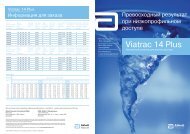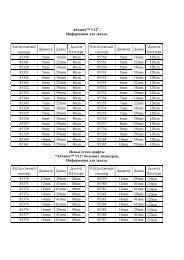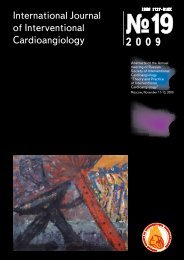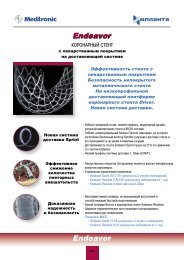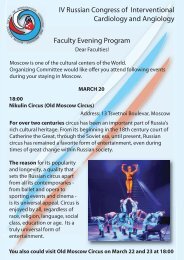International Journal of Interventional Cardioangiology
International Journal of Interventional Cardioangiology
International Journal of Interventional Cardioangiology
Create successful ePaper yourself
Turn your PDF publications into a flip-book with our unique Google optimized e-Paper software.
INTERVENTIONAL CARDIOLOGY<br />
coronary arteries after endovascular correction (10).<br />
The scores for affected arteries were determined<br />
using a scale specially developed at the A.N. Bakulev<br />
Scientific Center for Cardiovascular Surgery under<br />
the direction <strong>of</strong> pr<strong>of</strong>essor Yu.S. Petrosyan. Further,<br />
after the intervention the scores were summated so<br />
that only treated arteries were included in this sum.<br />
The ratio <strong>of</strong> the sum <strong>of</strong> operated arteries scores<br />
to absolute maximal sum <strong>of</strong> all arteries scores (240)<br />
represents the parameter we proposed to call "revascularization<br />
index”.<br />
Revascularization<br />
index<br />
The ratio <strong>of</strong> revascularization index to preoperative<br />
total score <strong>of</strong> coronary lesion is expressed<br />
as percentage and represents the indicator <strong>of</strong> the<br />
degree <strong>of</strong> revascularization.<br />
Degree <strong>of</strong><br />
revascularization<br />
=<br />
=<br />
Sum <strong>of</strong> operated arteries<br />
scores<br />
240<br />
Revascularization index<br />
Total score <strong>of</strong> coronarylesion<br />
) 100<br />
Thus, the method we have suggested allowed<br />
to assess the efficacy <strong>of</strong> endovascular treatment in<br />
CHD, and to determine a plan <strong>of</strong> further treatment in<br />
cases <strong>of</strong> incomplete revascularization.<br />
STUDY RESULTS AND DISCUSSION<br />
The following results were obtained during performed<br />
study.<br />
One hundred seventy nine (83%) out <strong>of</strong> 216 coronary<br />
lesions were corrected. Stenting <strong>of</strong> 154 stenoses<br />
was performed, among these 114 (74%) stenoses<br />
were eliminated by direct stenting, 40 (26%) – by<br />
indirect stenting. Eighteen (12%) antiproliferative<br />
drug-eluting stents (Cypher, Axion) were implanted.<br />
Twenty five (60%) out <strong>of</strong> 42 occlusion lesions<br />
were eliminated by stenting with predelatation.<br />
Correction <strong>of</strong> 20 (9%) stenoses and 17 (40%)<br />
occlusions failed due to different reasons.<br />
Analysis <strong>of</strong> the relation between the LCII, EF,<br />
DD and the degree <strong>of</strong> revascularization in all operated<br />
patients at 24 months after stenting showed<br />
that the best results for myocardial contractility<br />
restoration and normalization <strong>of</strong> diastolic function<br />
and ejection fraction were obtained with complete<br />
revascularization (67%, 66%, and 82% <strong>of</strong> patients,<br />
respectively). Similar results were obtained with the<br />
revascularization degree <strong>of</strong> more than 80% (64%,<br />
67%, 75% <strong>of</strong> patients, respectively). With the revascularization<br />
degree <strong>of</strong> 50-80% LCII improved in 36%<br />
<strong>of</strong> cases, EF improved in 33%, and diastolic function<br />
improved in 57% <strong>of</strong> patients. With incomplete revascularization<br />
<strong>of</strong> less than 50% the positive changes in<br />
LCII over time were revealed only in 11% <strong>of</strong> patients,<br />
in EF – in 25%, and in diastolic function – in 44% <strong>of</strong><br />
patients (Fig.1).<br />
Thus, in incomplete restoration <strong>of</strong> coronary<br />
blood flow, the more pronounced positive changes<br />
over time in the main functional parameters were<br />
achieved with the degree <strong>of</strong> revascularization <strong>of</strong><br />
more than 80%.<br />
<br />
LCII, EF, DD normalization depending on the degree <strong>of</strong><br />
revascularization in Q-wave and non Q-wave MI patients<br />
in long-term follow-up after stenting<br />
<br />
<br />
<br />
<br />
<br />
<br />
<br />
<br />
<br />
<br />
<br />
<br />
<br />
<br />
<br />
<br />
Figure 1. LCII, EF, DD improvement depending on the degree <strong>of</strong><br />
CONCLUSIONS<br />
Conception <strong>of</strong> the degree <strong>of</strong> revascularization,<br />
proposed for the first time in this work, and its quantitative<br />
characteristics allow to assess the efficacy <strong>of</strong><br />
endovascular treatment in CHD patients.<br />
Calculation <strong>of</strong> this parameter after surgical intervention<br />
allows for the determination <strong>of</strong> the strategy <strong>of</strong><br />
further patient treatment.<br />
With the degree <strong>of</strong> revascularization <strong>of</strong> 80%<br />
and more, the changes in LV myocardial functional<br />
parameters over time are comparable with those <strong>of</strong><br />
100% coronary blood flow restoration.<br />
When complete correction <strong>of</strong> coronary atherosclerotic<br />
lesion is impossible, achievement <strong>of</strong> partial<br />
luminal restoration in coronary arteries (with the<br />
degree <strong>of</strong> revascularization <strong>of</strong> at least 80%) should<br />
be reasonably considered as suboptimal result <strong>of</strong><br />
surgical intervention.<br />
References:<br />
1. Moustapha A., Anderson H.V. Revascularization interventions<br />
for ischemic heart disease. Curr. Opin. Cardiol., 2000,<br />
15, 463 – 471.<br />
2. F.E. Ageev, A.A. Skvortsov, V.Yu Mareev, Yu.N. Belenkov.<br />
Heart failure in coronary heart disease: Some issues <strong>of</strong> epidemiology,<br />
pathogenesis and treatment. Russkij Medicinskij<br />
Zhurnal, 2000, 15 -16, 622 – 626.<br />
3. G.M. Solovjev, O.Yu. Shaenko. Actual issues <strong>of</strong> surgical<br />
treatment in coronary heart disease. Kardiologija, 1997, 4,<br />
76 – 79.<br />
4. N.A. Mazur. Effective and safe treatment methods<br />
in patients with chronic coronary heart disease. Russkij<br />
Meditsinkij Zhurnal, 1998, 6, 14, 908 – 913.<br />
Assessment <strong>of</strong> the Degree <strong>of</strong> Myocardial Revascularization<br />
in Patients with Coronary Heart Disease<br />
29




